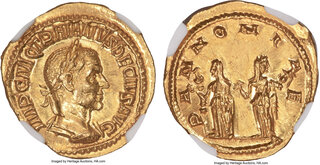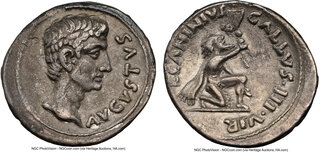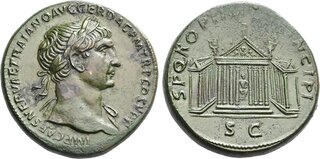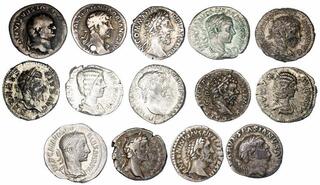| London Coins Ltd. > Auction 183 | Auction date: 2 December 2023 |
| Lot number: 1314 Price realized: 220 GBP (Approx. 278 USD / 256 EUR) Note: Prices do not include buyer's fees. | |
| Lot description: Roman Empire 14-Emperor Collection in silver comprising Denarius (8) and Antoninianus (6), one coin each of Vespasian, Trajan, Faustina Sr., Marcus Aurelius, Septimus Severus, Jukia Domna, Caracalla, Severus Alexander, Gordian III, Philip I, Trajan Decius, Trebonius Gallus, Valerian I, and Gallienus, Fair to Good Fine, housed in a presentation box with Certificate of Authenticity, Roman Empire 20-Emperor Collection in bronze 3rd and 4th Century comprising Ae3 and Ae4 issues one from each Emperor as follows: Galienus, Victorinus, Tetricus I, Tetricus II, Claudius II, Aurelian, Probus, Diocletian, Licinius I, Constantine I, Constantine II, Constans, Constantius II, Constantius Gallus, Julian II, Valentinian I, Valens, Gratian, Valentinian II and Theodosius I VG to Fine in a presentation box with booklet Estimate: 100-200 GBP Starting price: 100 GBP |
Match 1:
Match 2:
Match 3:
Match 4:
| Leu Numismatik AG > Auction 15 | Auction date: 1 June 2024 |
| Lot number: 270 Price realized: This lot is for sale in an upcoming auction - Bid on this lot  | |
| Lot description: Antoninus Pius, 138-161. Military Diploma (Bronze. Tabula 1: 189x162 mm, 274.44 g, 3 h. Tabula 2: 188x162 mm, 314.34 g, 6 h), for Q. Munatius Mestris, son of Mucatralus, soldier in the Praetorian fleet of Misenum. Caecius Severus, fleet prefect, issued during the reign of Antoninus Pius, on 30 September 141, in the consulship of M. Vettius Valens and Ti. Claudius Saturninus. Unpublished and highly interesting. An exceptionally complete and attractive military diploma for a Thracian fleet soldier preserving both tabulae. Both tabulae pierced three times, otherwise, extremely fine. From a European collection, formed before 2005. Tabula 1 | Obverse IMP(erator) CAESAR DIVI HADRIANI F(ilius) DIVI TRAIANI PARTHICI NEPOS DIVI NERVAE PRONEPOS T(itus) AELIVS HADRIANVS ANTONINVS AVG(ustus) PIVS PONT(ifex) MAX(imus) TRIB(unicia) POTEST(ate) IIII CO(n)S(ul) III P(ater) P(atriae) IIS QUI MILITAVERUNT IN CLASSE PRAETORIA MISENENSI QVAE EST SVB CAECIO SEVERO SEX ET VIGINTI STIPENDI(i)S EMERIT(is) DOMISSIS (sic!) HO- NESTA MISSIONE QVORVM NOMINA SVB- SCRIPTA SVNT IPSIS LIBERIS POSTERISQVE EORVM CIVITATEM ROMANAM DEDIT ET CO- NVBIVM CVM VXORIB(us) QVAS TVNC HABVS- ISSENT (sic!) CVM EST CIVITAS IIS DA[T]A AVT SI QVI CAELIBES ESSENT CVM I(i)S QVAS POSTEA DV- XISSENT DVMTAXAT SINGVLI SINGVLAS PR(idie) K(alendas) OCTOBR(is) M(arco) VETTIO VALENTE CO(n)S(ulibus) TI(BERIO) CLAVDIO SATVRNINO EX GREGALE Q(uinto) MVNATIO MESTRI F(ilio) MVCATRALI ANCHIAL(o) EX BESSIA DESCRIPTVM ET RECOGNITV(m) EX TABVLA AEREA QVAE FIXA EST ROMA(e) IN MVRO POST TEMPLV(m) DIVI AVG(usti) AD MINERVA(m) Translation: 'Imperator Caesar, son of the deified Hadrian, grandson of the deified Trajan Parthicus, great-grandson of the deified Nerva, T. Aelius Hadrianus Antoninus Augustus Pius, pontifex maximus, holding tribunician power for the fourth time, consul for the third time and father of the country. (He) has granted Roman citizenship to those who have served as a soldier in the Praetorian fleet of Misenum, which is under the command of Caecius Severus, (who), after twenty-six years of service, have been honorably discharged, whose names are written below, to themselves, their children and descendants, and the right of legal marriage with the spouses they had at the moment when citizenship was given to them, or, if any were unmarried, with those whom they later married, insofar as each has only one (wife). (Issued) the day before the Kalends of October, in the consulship of M. Vettius Valens and Ti. Claudius Saturninus. From the ranks of the common soldiery: (These rights were granted) to Q. Munatius Mestris, son of Mucatralus, from Anchialus (and) from Bessia. Copied and checked from the bronze tablet which is attached to the wall in Rome behind the Temple of the Deified Augustus next to Minerva.' Tabula 1 | Reverse IMP(erator) CAESAR DIVI HADRIANI F(ilius) DIVI TRAIANI PARTH(ici) NEP(os) DIVI NERVAE DRONE(pos) (sic!) T(itus) ATL(ius) (sic!) HADRIANVS ANTONINVS AVG(ustus) PIVS PON(tifex) MAX(imus) TRIB(unicia) POT(estate) IIII CO(n)S(ul) III P(ater) P(atriae) I(i)S QUI MILTTAVER(unt) (sic!) IN CLMSE (sic!) PR(aetoria) MISEN(ensi) QVAE EST SVB CAECIO [S]EVERO XXVI STIPEND(iis) EME- RIT(is) DIMISSI(s) HONESTA MISSION(e) QVORVM NOMIN(a) SVBSCRI[PT]A SVNT CIVITAT(em) ROMAN(am) QVI TORVM (sic!) NON HABER(ent) DED(i)T [E]T CONVB(ium) CVM VXOSIB(us) (sic!) QVAS TVNC HABVIIS(ent) (sic!) CVM EST CIVITAS DIS (sic!) DATA AVT SI QVI CAELIB(es) ESSENT OVM (sic!) I(i)S QVAS POSTEA DVXISS(ent) DVMTA- XAT SINQVN (sic!) SINGVLAS Translation: 'Imperator Caesar, son of the deified Hadrian, grandson of the deified Trajan Parthicus, great-grandson of the deified Nerva, T. Aelius Hadrianus Antoninus Augustus Pius, pontifex maximus, holding tribunician power for the fourth time, consul for the third time and father of the country. (He) has granted Roman citizenship, should any of them not have it, to those who have served as a soldier in the Praetorian fleet of Misenum, which is under the command of Caecius Severus, (who), after twenty-six years of service, have been honorably discharged, whose names are written below, and the right of legal marriage with the spouses they had at the moment when citizenship was given to them, or, if any were unmarried, with those whom they later married, insofar as each has only one (wife).' Tabula 2 | Obverse TI(beri) CLAVDI MENANDRI P(ubli) ATTI SEVERI L(uci) PVLLI DAPHNI P(ubli) ATTI FESTI M(arci) SENTILI IASI TI(iberi) IVLI FELICIS C(ai) IVLI SILVANI Translation: (Witnessed by) Ti. Claudius Menander P. Attius Severus L. Pullius Daphnus P. Attius Festus M. Sentilius Iasus Ti. Iulius Felix C. Iulius Silvanus Tabula 2 | Reverse PR(idie) K(alendas) OCTOBR(is) M(arco) VETTIO VALENTE CO(n)S(ulibus) TI(berio) CLAVDI(o) SATVRNINO EX GREGALE Q MVNATIO MESTRI F(ilio) MVCATRALI ANCHIAL(o) EX BESSIA Translation: (Issued) the day before the Kalends of October, in the consulship of M. Vettius Valens and Ti. Claudius Saturninus. From the ranks of the common soldiery: (These rights were granted) to Q. Munatius Mestris, son of Mucatralus, from Anchialus (and) from Bessia. This splendid and complete military diploma was issued on 30 September 141, during the reign of Antoninus Pius, for a soldier who had served in the Roman fleet stationed at Misenum in Italy, almost a full year before the equally interesting diploma sold in Leu 13 (2022), 324. As mentioned there, Rome possessed two major naval bases in Italy, one at Misenum (near Naples) directed towards the Tyrrhenian Sea, and one at Ravenna towards the Adriatic, in addition to smaller bases scattered across the Mediterranean and North Sea. Each of the Italian fleets was headed by a praetorian prefect, the most famous of whom was no doubt Pliny the Elder, who died in his capacity as prefect of the Misene fleet when he organized a rescue mission for the victims of the Vesuvius' eruption in 79. Although the Empire generally had little to fear from any foes on open water, at least until the Germanic invasions of the 3rd, 4th, and 5th centuries, its navy was vital in securing shipping lanes from pirates, and it played an important role in official transport and communication, while fleet soldiers could also perform guard duties on land when needed. Before the so-called Constitutio Antoniniana was enacted under Caracalla in 212, granting Roman citizenship to all free men in the Empire, military service offered one of the surest paths towards citizenship and social promotion for many provincials. A career in the navy lasted twenty-six years, after which the soldier received citizenship for himself and his descendants, and the right of legal marriage. Often, soldiers were discharged en masse, after which a bronze plaque would be produced and set up in the capital recording the grant, each veteran receiving an individual copy, the so-called military diploma. These consisted of two bronze tablets sealed to one another, the first one (tabula 1) recording the rights and the names of the soldier and his family, the other (tabula 2) the seven witnesses present. To avoid tampering with the text, the inside of the tablets was inscribed with a copy of tabula 1, though usually less refined and with a high number of abbreviations, as is obviously the case here. If there was suspicion of fraud, the seals could be broken and both versions compared without having to journey to Rome to inspect the original. This diploma preserves both tabulae, and was issued for Q. Munatius Mestris, son of Mucatralus, hailing from Anchialus, then part of Bessia, a larger area within Thrace named for the Bessi, a warlike tribe living in the Thracian interior. Indeed, both Munatius Mestris and his father Mucatralus, have names of Thracian origin. While the Bessi themselves did not have a seafaring tradition, the cities of the Thracian coastline obviously did, and these provided fertile recruitment grounds for the Roman fleet. The Misene fleet at this time was commanded by Caecius Severus. Nothing his known of his further career, but two other military diplomas show that he was prefect in 139, while the diploma sold in Leu 13 indicates he was replaced at least before October 142, providing a terminus ante quem for the end of his career as prefect of the fleet. More exciting are the suffect consuls, M. Vettius Valens and Ti. Claudius Saturninus, as this is their first attestation as suffect consuls together. First, M. Vettius Valens is probably to be identified with the Vettius Valens whose career is attested by an inscription found in Ariminum (CIL XI, 383). The pinnacle of his career was no doubt the command of the Legio XV Apollinaris, in which capacity he served under the governor of Cappadocia, the historian and philosopher Arrian, to repel an invasion of Alans late in the reign of Hadrian, before being awarded the suffect consulship under Pius. Ti. Claudius Saturninus, on the other hand, is known to have been the governor of Gallia Belgica under Hadrian in 136/7, while he later held the important governorship of Moesia Inferior under Pius from 144 to 147. Finally, this diploma sets itself apart by preserving both tabulae. Many diplomas are only preserved in a fragmentary state, or, if complete at all, only consist of one tabula. All the more amazing then is that we have both tabulae in excellent condition. As expected, the outside of tabula 2 is a list of witnesses ratifying the document, a standard feature of ancient law, especially for something as momentous as the grant of citizenship. As these were officials, they unsurprisingly appear in other military diplomas of the same time period. All in all, this diploma is another wonderful example of the administrative strength from which Rome drew much of its power. Members of provincial societies could hope for social (and economic!) advancement through military service, and this conditional inclusiveness helped mould the Empire into an entity whose legacy would long outlive its political existence. . Estimate: 10000 CHF | 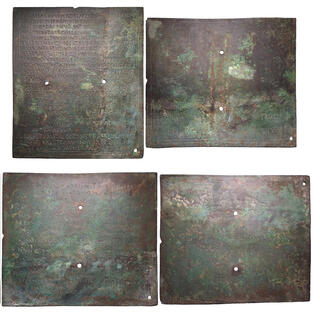 |
Match 5:



